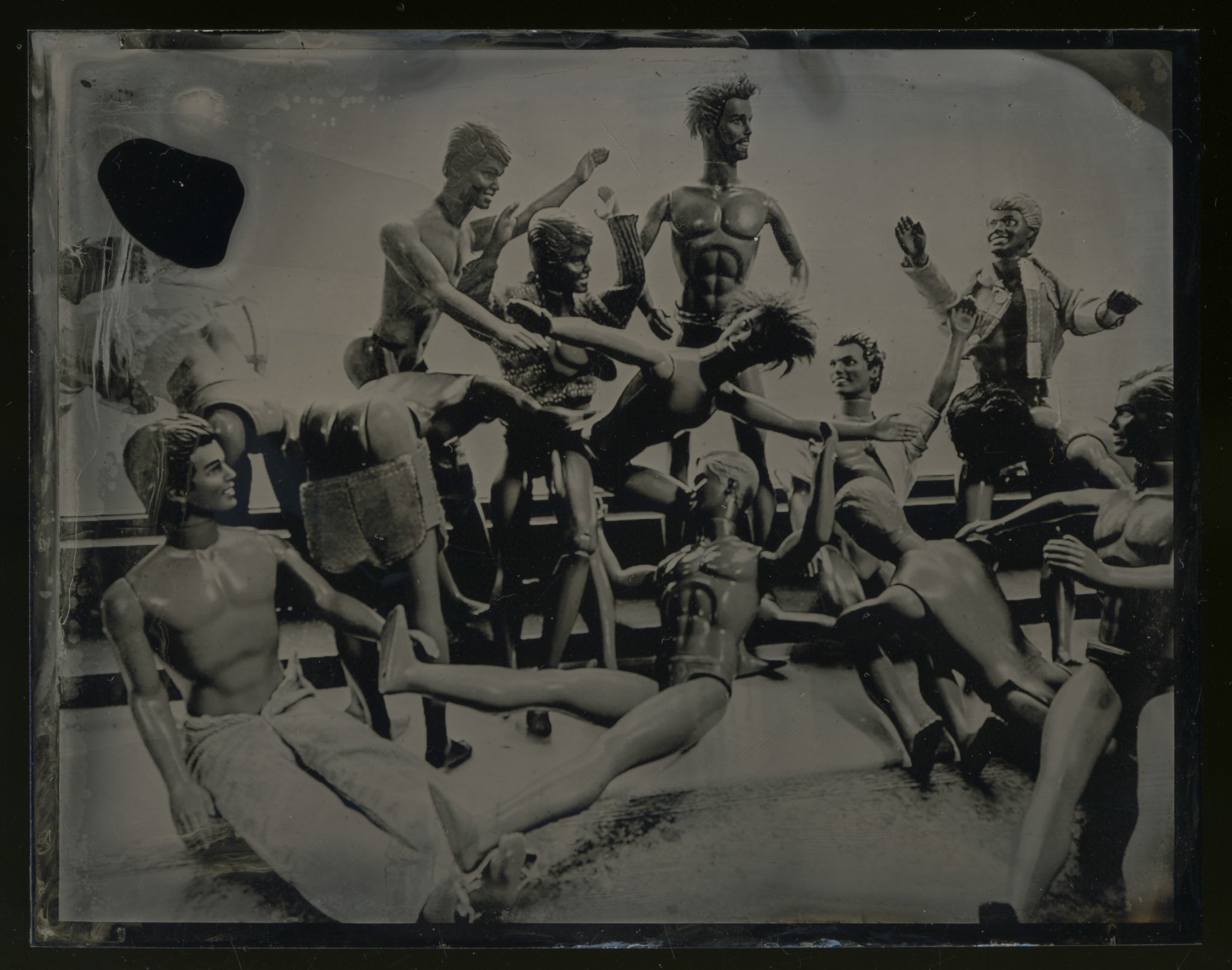Christ is Ken is a series of tin type photographs that restage Biblical scenes using nude Ken Barbie dolls from the 1990s. The images were created by Colton, an imaginary, Christian, gay, teenage pastor’s son from the 1800s who never saw gay lovers. Colton uses his extensive knowledge of Bible stories to hide his forbidden desires.
…Full statement continues at bottom of page.
Christ is Ken
Christ is Ken is a series of tin type photographs that restage Biblical scenes using nude Ken Barbie dolls from the 1990s. The images were created by Colton, an imaginary, Christian, gay, teenage pastor’s son from the 1800s who never saw gay lovers. Colton uses his extensive knowledge of Bible stories to hide his forbidden desires.
Tin Types communicate a preciousness of both subject and object that other mediums lack. Because they require vintage equipment: a 4” x 5” accordion camera, tin plates, and collodian, they produce a haunting black and white image that feels powerfully historical. The physical quality of the plates–the coolness of the metal against one’s fingers or the scratches revealing the fragility of the emulsion–stand in contrast to the detritus of 6,000 digital images on an iPhone. It emphasizes the love and care that Colton feels for his Barbies.
Ken was the perfect model. To produce a tin type, the sitter must hold perfectly still for a 10-minute exposure. Consequently, most subjects have relaxed faces with a closed mouth, (who could hold a smile for 10 minutes?), while the blurred edges around the eyelids and hands communicate a sense of movement. This wasn’t an issue for Ken. He maintained a perfectly manicured smile, never blinking or fidgeting. Yet his presence communicates a contradiction. Mattel created its first Barbies in the 1960s, yet the tin types reference the 1860s. Can two truths coexist? Beyond his stillness, Ken represents the glory and intolerance of the American ideal male: tall, white, chiseled torso, bulging abs, silky straight brown hair, blue eyes, able-bodied, late 20s, porcelain veneers, insanely tan, and also… a eunuch. His speedo is a permanent fixture, the same color as his Hollywood spray tan. There is no bulge of cock and balls. His castration offers comfort and safety.
In “Adam and Steve,” Ken wraps his arms around a blond, skinny, boyish Steve. After Eve tricked him with that damn fruit, he has abandoned her in search of a lusty twink. Steve stands a head shorter than Adam while both lovers stare off camera at the garden of Eden, caught by chance in a moment of intimacy. Ken wears a small loin cloth, offering a peekaboo view of his Barbie “penis.” On the horizon, the viewer can make out all 36 floors of the luxury apartment building 100 Kingshighway. Designed by Jeanne Gang, it symbolizes the new Central West End, an up-and-coming neighborhood in St. Louis. This is the view out Colton’s bedroom window, a private space with a public vista, where he can play behind closed doors with the mirage of an accepting city in the background. The swirls of collodion and developer remind the viewer of the artist’s hand. This is a fetishized art object, a process prone to mistakes. Its presence employs and condemns the digital world in the same breath.
In “David and Jonathan’s Last Kiss,” the two lovers, competing heirs to the throne of Israel, meet in a thick grove of leaves to say a last goodbye. Jonathan’s father, King Saul, is determined to destroy David, son of Jesse. But Jonathan warns David of the king’s plot, saving his life and preserving the line of Christ twenty-seven generations later. Their story could be a testament to homosexual love. It provides Colton with a glimmer of hope. If Jesus had a gay ancestor, perhaps he can maintain his Christian heritage and his sexual desire?
The series was inspired by Zoe Leonard, a lesbian artist who worked with Cheryl Dunye to create the Fae Richards Archive. After noticing a lack of Black, lesbian representation in the history of Hollywood films, Leonard created a fake archive to fill the gap. Similarly, Christ is Ken utilizes camp, a self-aware hyperbole, to create an archive of gay imagery from the 1800s. It was also influenced by the painter Kehinde Wiley, the illustrator Tom of Finland, and the photographer Wilhelm Von Gloeden. Wiley recreates historical paintings with contemporary black figures in the same way that Ken stands in for Jesus. Tom of Finland is a collection of hand-drawn, gay, pornographic cartoons. Lastly, Wilhelm Von Gloeden was a German photographer from the 19th century who photographed nude Sicilian boys in scenes of fake antiquity. Many of Von Gloeden’s homoerotic images were clandestinely collected and traded within the queer community, the gay version of baseball cards. Together, these artists gave Colton the courage to create work about sex.
When I was about ten, I attended a month-long summer camp in Alabama: Alpine Camp for Boys. As we unpacked on our first day, news spread that Colton had been assigned to our cabin. The other boys groaned. Colton walked in with a set of three Ken Barbie dolls dressed as G.I. Joe Soldiers. “They’re not Barbies,” he quickly informed us. But the damage was done. We ostracized him, fearing the damage to our own fragile reputation if we were associated with such a loser. Secretly, I wanted to play with those Barbies. My own Teddy and Kitty were hidden safely under my pillow. But I could smell social suicide and avoided Colton like everyone else. Now, I’m reimagining my past. What if things had been different? At 34, I’m giving myself permission to be that kid again, playing with the Barbies I denied myself.












